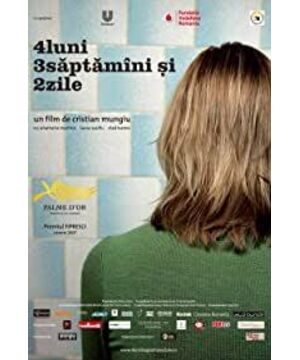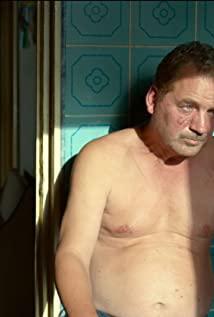The 2007 Cannes Film Festival’s main competition unit gathered famous people: Bella Tal’s "The Man from London", Alexander Sokolov’s "Alexandra", Quentin Tarantino’s "Ring Room", Fatih ·Akin "On the Other Side of Life", Coen Brothers "Old Nowhere", Lee Cangdong "Miyang", Wong Kar Wai "Blueberry Night", Gus Van Sant "Psychedelic Park", Carlos Regadas "The Light of Silence", James Gray "We Have the Night", Kusturica "Give Me a Promise", David Fincher "The Zodiac". This is a very obvious Cannes New Year. Surprisingly, it was not these masterpieces who won the Palme d'Or. Romanian director Christian Mungi, who was not optimistic in advance, aspires to Palme d'Or with "April Three Weeks and Two Days".
"April, Three Weeks and Two Days" is only Mongi's second feature film, and this phenomenon is also rare in the history of Cannes. Now that more than a decade has passed, the film has not become a classic of the new century, but the reputation has not fallen as rapidly as some palmetoises. "April, Three Weeks and Two Days" is a typical third-world art film, with outstanding social issues that provoke people's hearts, and its formal style is extremely strong. The work seems profound and sharp on the surface, but after careful analysis, some problems are quite obvious, especially the suspicion of formulating. These problems also exist in directors in similar third world countries. The root causes of the problems are related to the director's own creative mentality, and also to the generation mechanism of Western film festivals and the cultural mentality of Orientalism. In a sense, this is a collusion.
"April, Three Weeks, Two Days" has a very popular theme in Western society: abortion. Abortion has always been a controversial topic in Christian countries. But Mengji's approach is different from the usual abortion-themed movies. The subject of abortion in the film is not religion, but totalitarian politics. The totalitarian government of Ceausescu, which has ruled Romania for many years, prohibits abortion is one of its most obvious tyranny. According to the well-known historian Tony Judt's "Post-War History of Europe", since 1966, the Romanian government began to implement a brutal policy of prohibiting abortion in order to increase the population. Women under the age of 40 with fewer than 4 children are absolutely prohibited from having an abortion. In 1986, the restricted age was mentioned to be 45 years higher. To prevent abortion, every Romanian woman of childbearing age is forced to undergo a mandatory medical examination every month. The huge tragedy brought about by this policy is that the population of Romania has not grown, but the death rate caused by abortion far exceeds that of European countries, because illegal abortion has become the only method of birth control. After the 1966 law prohibits abortion, at least 10,000 women die every year. By 1985, newborns must survive more than four weeks before they can be registered. On the eve of the overthrow of the Ceausescu regime, the neonatal mortality rate reached a heinous 25%!
If we are to find a dramatic social fact that reflects the harshness of the Ceausescu regime, there is nothing more appropriate than a policy of banning abortion. Mengji's choice is very keen. If a third world country chooses a completely depoliticized theme and shoots purely emotional movies like "Two Lovers" (2008), "The Ghost of Ismail" (2017), and "Night and Day" (2018), you must If you want to compete in a film festival, you may not even get the tickets. On the contrary, the higher the political intensity of the selected subject matter, the higher the probability of being selected.
Of course, eye-catching issues are not enough. Top film festivals also have specific requirements for the aesthetic pursuit of films. It is definitely not possible to make a Hollywood movie like front and back shots, seamless editing, and stick to the principle of 180-degree axis (only Eastwood and individual Hollywood stars have this power). The aesthetic style of "April, Three Weeks and Two Days" can be classified into two categories. One is a long lens with a fixed lens. The effect is similar to a window lens. The two heroines became the objects to be deeply watched, watched and even stared at. Especially for the major abortion that took place in a hotel for more than half an hour, Mengji all used the aesthetic strategy of a close-up long lens with a fixed lens. In some scenes, the female protagonist’s lower body is completely naked, while the private parts are half-naked, forming a peeping effect, which is erotic to heterosexual men. The subject of the state projected from this also becomes the object to be viewed. The process of gathering and talking at the dinner table at the hostess's guest boyfriend's home is also a long lens with a fixed lens. Because the focus of this process is to show the situation of people in Romanian society at that time, including economic status and political status.
Hand-held camera follow-up is another major feature. This is similar to the viewpoint of the tunnel effect, and the audience has a sense of presence. The use of no soundtrack strengthens the realistic and documentary style.
The narrative style that matches the image style is very Hollywood. This is also the agility of Mengji. The obscure modernist narrative with the loose causal chain of Antonioni does not have a natural advantage in film festival competitions. This is due to the identity of the judges. After all, the judges are not film critics or film theorists who have read countless films. The narrative of "April, Three Weeks and Two Days" is full of Hitchcock's suspense style. From the first line "Okay"-"Thank you" and the sound of the clock countdown (which symbolizes the collapse of the regime), suspense persists throughout the movie: What are these two heroines going to do? Can the room be booked? Can the ticket check on the bus be handled? Are doctors willing to trade or not? Why doesn't the girl answer the phone? Is something wrong? How do girls deal with her boyfriend's blame? This is the conventional narrative rule of event movies. In addition, the Hollywood narrative rule is that there must be a love clue in addition to the main clue. This film also fully complies with this principle. The "collusion" of these two clues ensures that the film has nothing to do with boring and dullness.
The significance of this choice of strategy is not limited to this. The combination of a strong realistic style of audiovisual language and the development of dramatic events, the result is actually a kind of accusatory image aesthetics. According to classical Bazin aesthetics, the combination of a long lens and a fixed lens must be related to facts, truths, and archives. The subject of watching, watching and even gazing becomes the witness and accuser of history. An endowment of identity related to moral status. So the climax of the film will be a close-up of the dead baby, which is the evidence of Ceausescu's demonic regime. As the subject of viewing, we have all become witnesses of history. At the end of Wang Bing's new film "Dead Soul", the camera is aimed at the bones left at the original location of Jiabiangou, with the same accusing effect. This is a performance that is difficult for the photographer to control himself. Similar to the angrily protest of the plaintiff in court after losing control of his emotions.
In the last shot of the film, even the heroine looks at the camera, that is, the audience. The questioning is strong-have you all seen it?
The life course of the dead baby-three weeks and two days in April-is the title of the film. Here we can go back and examine the image logic of the entire film. The story is full of suspense and ups and downs, guided by the "realistic" and "documentary" styles formed under the control of manual operation, we are very concerned about the fate of the two girls. Along with the development of extraordinary events, we have felt the strange feelings, worried and anxious for them, sincerely looking forward to being able to tide over the difficulties, and finally getting what we wished, we are calm in our hearts. At the same time, we also understand and witness the terrible Ceausescu regime. But beyond that, what else does the film leave us?
We may be able to compare event movies of the same subject matter. Robert Bresson’s "Death Convict Escape" is a movie about the story of a prisoner who escaped from prison by risking his death during the Nazi occupation of France. This is also a very typical event-based movie. How does the prisoner protagonist escape from prison? Can it succeed? This process is the main line of the narrative of the whole movie, and this main line projects the inhumanity of the Nazi regime. But Bresson's aesthetic interest and accompanying life demands are quite different from "April Three Weeks and Two Days". Bresson had no intention of using historical facts as evidence to accuse the Nazis. His method was to allow the audience to fully experience the relationship between the protagonist and the environment. The space outside the painting, alien performance, frequent close-ups of hands, loose chain of cause and effect, non-dramatic monologues, and Mozart masses in C minor with strong redemptive meaning, make the relationship between the protagonist and the environment constitute a deep image situation ( What Deleuze calls pure audio-visual situations, that is, time-image). Bresson did not focus on amplifying the suspense of the escape process. The protagonist's body, actions, and voice construct a pure image of existence. What's more special is that Bresson's image aesthetics is not for the sake of form. The space outside the painting is part of Bresson's own experience of imprisonment. Therefore, the existence of images is not a teleological artificial technique, but a solemn projection of the subject's life experience. And all of this is actually the Nazi experience of the existence subject.
To be precise, the technique of "April Three Weeks and Two Days" is display, video display. Not even revealing. We can compare Mikhalkov's "Scorching Man". The strong point of this film is that it finds a very special angle to reveal the horror of the Stalinist era. Throughout the film, there are scenes of playfulness between adults and children, sincere and pretentious, history and future, loyalty and betrayal, love and hate, developed in a very complex and true dialectical relationship, which is full of human horror. Echo. Until the appearance of the portrait of Stalin, the film barely touched on the words of this era. But everything in the era is reflected in this special relationship and state of characters.
"April Three Weeks and Two Days" is essentially a non-fictional news report, thin and weak. After watching the movie, we learned about the abortion tragedy of the Romanian people under the control of the Ceausescu regime and about Romanian university students. If you don’t study science and engineering, you have to go to the countryside to be a farmer. You know the special rules for booking rooms in Romanian hotels, you know the universality of bribery and the extreme lack of materials in Romania at that time... The creation of the two heroines in the film is also relatively simple, one Cowardly, an independent. Our perception of it is nothing more than--there are people like this, typical of that era. A typical character in a typical environment-"April Three Weeks and Two Days", after all, is still the product of this stale, stereotyped, and outdated literary theory.
(Already published in the "Evil Theory" column of Iris)
View more about 4 Months, 3 Weeks and 2 Days reviews










